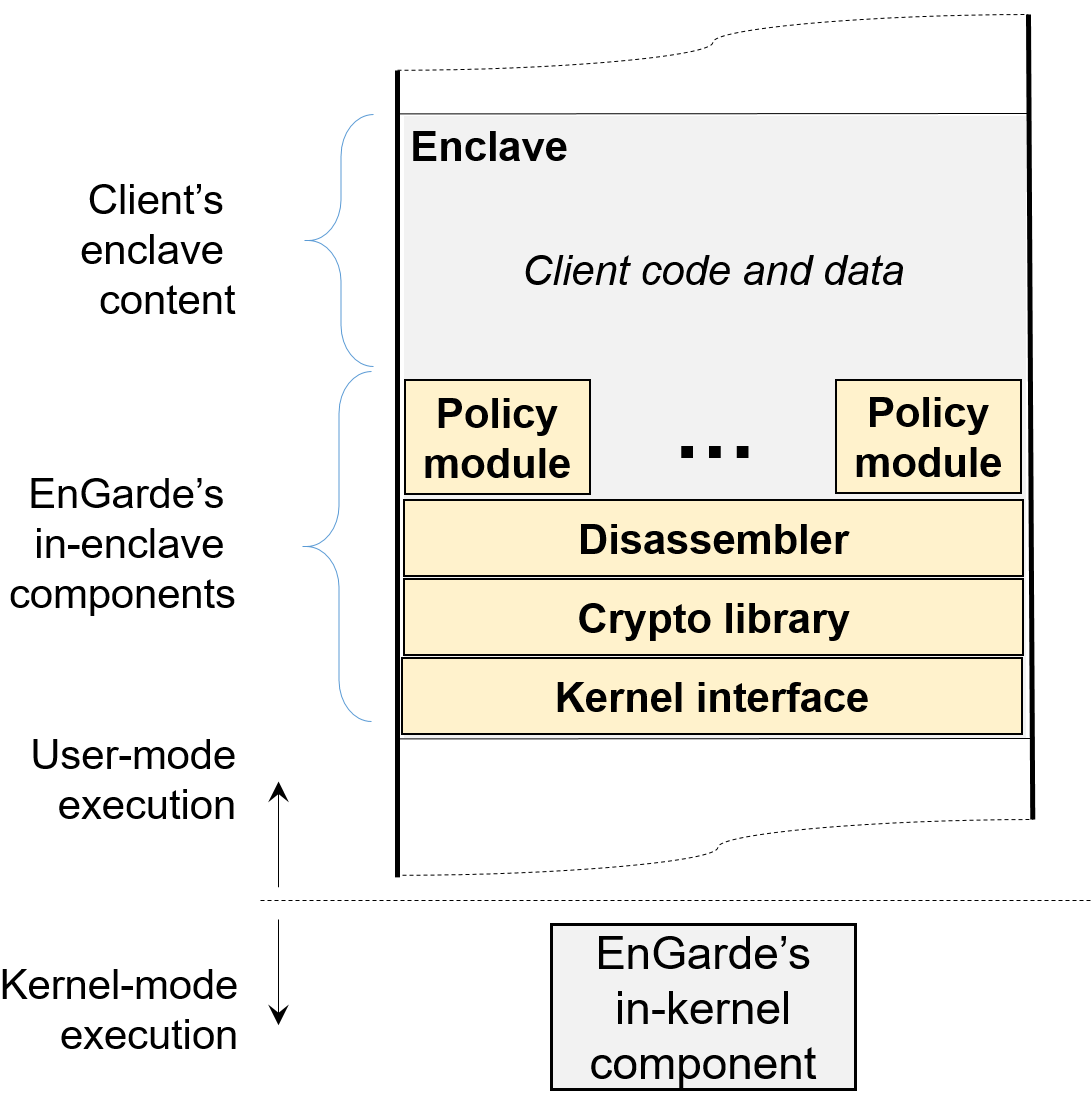This work appears in the 2017 International Conference on Distributed Computing Systems (ICDCS 2017)
In recent years, the research community has devoted much attention to security and privacy threats that arise in public cloud computing platforms, such as Amazon EC2 and Microsoft Azure. From the perspective of cloud clients, one of the chief security concerns is that the computing infrastructure is not under the client’s control. While relinquishing control frees the client from having to procure and manage computing infrastructure, it also exposes the client’s code and data to cloud providers and administrators. Malicious cloud administrators can compromise client confidentiality by reading sensitive code and data directly from memory highlights_scroll of the client’s virtual machines (VM). They could also inject malicious code into client VMs, e.g., to insert backdoors or log keystrokes, thereby compromising integrity. Even otherwise honest cloud providers could be forced to violate client trust because of subpoenas.
Intel’s SGX architecture offers hardware support to alleviate such client security and privacy concerns. SGX allows client processes and VMs to create enclaves, within which they can store and compute on sensitive data. Enclaves are encrypted at the hardware level using hardware-managed keys. SGX guarantees that enclave content that includes enclave code and data is not visible in the clear outside the enclave, even to the most privileged software layer running on the system, i.e., the operating system (OS) or the hypervisor. SGX also offers support for enclave attestation, thereby providing assurances rooted in hardware that an enclave was created and bootstrapped securely, without interference from the cloud provider. With SGX, clients can therefore protect the confidentiality and integrity of their code and data even from a malicious cloud provider or administrator, so long as they are willing to trust the hardware.
Despite these benefits, SGX has the unfortunate consequence of flipping the trust model that is prevalent on contemporary cloud platforms. On non-SGX platforms, a benign cloud provider benefits from the ability to inspect client code and data. The cloud provider can provide clients with services such as malware detection, vulnerability scanning, and memory deduplication. Such services are also beneficial to benign clients. The cloud provider can check client VMs for service-level agreement (SLA) compliance, thereby catching malicious clients who may misuse the cloud platform in various ways, e.g., by using it to host a botnet command and control server. In contrast, on an SGX platform, the cloud provider can no longer inspect the content of a client’s enclaves. This affects benign clients, who can no longer avail of cloud-based services for their enclaves. It also benefits malicious clients by giving them free reign to perform a variety of SLA-violating activities within enclaves. Researchers have discussed the possibility of such “detection-proof” SGX malware. Without the ability to inspect the client’s code, the cloud provider is left to using other, indirect means to infer the presence of such malicious activities.
SGX while still allowing the cloud provider to exert some control over the content of the client’s enclaves? One strawman solution to achieve this goal is to use a trusted-third party (TTP). Both the cloud provider and client would agree upon a certain set of policies/constraints that the enclave content must satisfy (as is done in SLAs). For example, the cloud provider could specify that the enclave code must be certified as clean by a certain anti-malware tool, or that the enclave code be produced by a compiler that inserts security checks, e.g., to enforce control-flow integrity or check for other memory access violations. They inform the TTP about these policies, following which the client discloses its sensitive content to the TTP, which checks for policy compliance. The cloud provider then allows the client to provision the enclave with this content.
However, the main drawback of this strawman solution is the need for a TTP. Finding such a TTP that is acceptable to both the cloud provider and the client is challenging in realworld settings, thereby hampering deployability. TTPs could themselves be subject to government subpoenas that force them to hand over the client’s sensitive content. From the client’s perspective, this solution provides no more security than handing over sensitive content to the cloud provider.
In this work, we present EnGarde, an enclave inspection library that achieves the above goal without TTPs. Cloud providers and clients agree upon the policies that enclave code must satisfy and encode it in EnGarde. Thus, cloud providers and clients mutually trust EnGarde with policy enforcement. The cloud provider creates a fresh enclave provisioned with EnGarde, and proves to the client, using SGX’s hardware attestation, that the enclave was created securely. The client then hands its sensitive content to EnGarde over an encrypted channel. It provisions the enclave with the client’s content only if the content is policycompliant. If not, it informs the cloud provider, who can prevent the client from creating the enclave.
EnGarde’s approach combines the security benefits of non-SGX and SGX platforms. From the cloud provider’s perspective, it is able to check client computations for policy-compliance, as in non-SGX platforms. From the client’s perspective, its sensitive content is not revealed to the cloud provider, preserving the security guarantee as offered by SGX platforms. Moreover, EnGarde statically inspects the client’s enclave content only once—when the enclave is first provisioned with that content. One can also imagine an extension of EnGarde that instruments client code to enforce policies at runtime, but our current implementation only implements support for static code inspection. Thus, except for a small increase in enclaveprovisioning time, EnGarde does not impose any runtime performance penalty on the client’s enclave computations. We have implemented a prototype of EnGarde and have used it to check a variety of security policies on a number of popular open-source programs running within enclaves.
